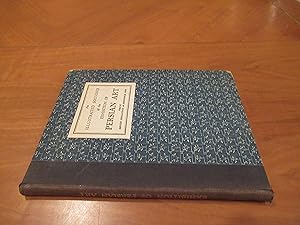About this Item
Xix,101 Annotated Plates. Black Cloth Spine, Gilt, Patterned Bluew Boards With White Printed Label . Business Card Of Smith, Secretary American Institute For Persian Art And Archaeology, With Presentation Inscription From Myron Bement Smith; Bookplate Of Sam A. Lewisohn (A Collector Primarily Of Impressionist Art). Classical Archaeologist, Architect, And Art Historian Myron Bement Smith (1897-1970) Had A Life-Long Devotion To West Asia, Accumulating Some 87,000 Items Now In The Smithsonian Archives Documenting Islamic Art And Culture From Spain To India, With An Emphasis On Architecture. Established In 1948 To Further An Appreciation For Persian Art And Culture, Nearly Seventy-Five Percent Of Smith's "Islamic Archives" Consists Of His Own Work; The Remainder Obtained From Other Sources. Smith's Own Negatives, Taken From 1933 To 1947, Accompany Images In A Six-Volume Logbook Portraying Persian Architecture And Monuments, In Particular The Vaulting Of The Masjid-I D'juma At Isfahan, Iran. One Of The Most Significant Portions Of The "Islamic Archives" Is The Photographic Material Of Antoin Sevruguin, A Commercial Photographer In Tehran Active During The 1870S To 1930. His Nearly 800 Photographs Depict The Shahs, Royal Palaces, Military Ceremonies, And Daily Aspects Of Persian Life. Other Materials In The Collection Include Smith's Personal And Professional Papers Including Correspondence, Research Files, Writings, And Documentation Regarding His 1927-1928 Italian And 1933-1937 Iranian Expeditions. In April 1930, Smith Was Appointed Secretary Of The Newly Created American Institute For Persian Art And Archaeology Founded By Arthur Upham Pope And Located In New York City. He Had No Prior Academic Or Work Experience In Islamic Art Or Architecture, And His Job Entailed Designing Publications, Arranging Lectures, Organizing Exhibitions And Fund Raising. That Summer He Arranged An Independent Study Course At Harvard University On Persian Art And Subsequently Studied Persian Language At Columbia University And Attended Graduate Courses At The Institute Of Fine Arts At New York University . His Work And Academic Credentials Enabled Him To Compete Successfully For A Research Fellowship From The American Council Of Learned Societies In 1933 To Study Iranian Islamic Architecture. Smith?S Research In Iran Consisted Of Meticulous Photographic Documentation Of Islamic Monuments And Architectural Sketches And Drawings Of Many Of Them. He Concentrated On The Isfahan Area But Also Documented Monuments Elsewhere In Iran. Smith Outfitted His Station Wagon As A Combination Camper And Research Vehicle In Which He And His Staff Traveled Widely. Smith Published Several Articles About Iran?S Islamic Monuments Based On His Field Research And In 1947 Completed His Phd Thesis For The Johns Hopkins University On The Vault In Persian Architecture. His Professional Career From 1938 Until His Death In 1970 Consisted Of A Series Of Temporary Academic Positions, Contract Work And Government Or Academic Sponsored Lecture Tours And Photographic Exhibits. He Had A Long Lasting Relationship With The Library Of Congress Where He Served As An Honorary Consultant From 1938 To 1940 And Again From 1948 To 1970; From 1943 To 1944 He Was Chief Of The Iranian Section At The Library. Despite His Lack Of Published Material, Smith Was Well-Known Among Academic, Government And Private Citizens Who Worked, Traveled Or Were Otherwise Interested Iran And The Islamic World. Smith Developed An Extensive Network Of Professional And Social Contacts That Dated From His Early Student Days And Increased Markedly During His Time At The Persian Institute And Later In Iran. He Kept In Touch With Them And They Touted Him To Others Who Were Interested In Iran Or Islamic Art And Architecture. This Network Served Him Well In Realizing His Ambition Of Creating A Resource For Scholars That Relied On Photographs To Document Islamic Architecture. Seller Inventory # 052639
Contact seller
Report this item
![]()
